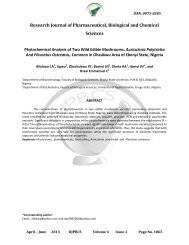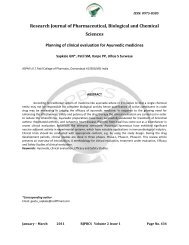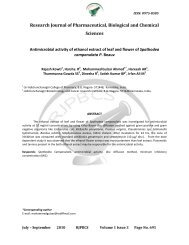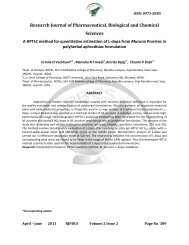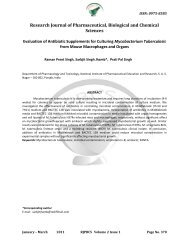A Pharmacognostic and Pharmacological Overview on Caesalpinia
A Pharmacognostic and Pharmacological Overview on Caesalpinia
A Pharmacognostic and Pharmacological Overview on Caesalpinia
Create successful ePaper yourself
Turn your PDF publications into a flip-book with our unique Google optimized e-Paper software.
Anti-amyloidogenic activity<br />
ISSN: 0975-8585<br />
Ramesh BN, et al., reported anti-amyloidogenic property of leaf aqueous extract of<br />
<strong>Caesalpinia</strong> crista. Amyloid beta (Abeta) is the major etiological factor implicated in Alzheimer's<br />
disease (AD). Abeta(42) self-assembles to form oligomers <str<strong>on</strong>g>and</str<strong>on</strong>g> fibrils via multiple aggregati<strong>on</strong><br />
process. The recent studies aimed to decrease Abeta levels or preventi<strong>on</strong> of Abeta aggregati<strong>on</strong><br />
which are the major targets for therapeutic interventi<strong>on</strong>. Natural products as alternatives for<br />
AD drug discovery are a current trend. We evidenced that <strong>Caesalpinia</strong> cristaleaf aqueous<br />
extract has anti-amyloidogenic potential. The studies <strong>on</strong> pharmacological properties of C. crista<br />
are very limited. Our study focused <strong>on</strong> ability of C. crista leaf aqueous extract <strong>on</strong> the preventi<strong>on</strong><br />
of (i) the formati<strong>on</strong> of oligomers <str<strong>on</strong>g>and</str<strong>on</strong>g> aggregates from m<strong>on</strong>omers (Phase I: Abeta(42)+extract<br />
co-incubati<strong>on</strong>); (ii) the formati<strong>on</strong> of fibrils from oligomers (Phase II: extract added after<br />
oligomers formati<strong>on</strong>); <str<strong>on</strong>g>and</str<strong>on</strong>g> (iii) dis-aggregati<strong>on</strong> of pre-formed fibrils (Phase III: aqueous extract<br />
added to matured fibrils <str<strong>on</strong>g>and</str<strong>on</strong>g> incubated for 9 days). The aggregati<strong>on</strong> kinetics was m<strong>on</strong>itored<br />
using thioflavin-T assay <str<strong>on</strong>g>and</str<strong>on</strong>g> transmissi<strong>on</strong> electr<strong>on</strong> microscopy (TEM). The results showed that C.<br />
crista aqueous extract could able to inhibit the Abeta(42) aggregati<strong>on</strong> from m<strong>on</strong>omers <str<strong>on</strong>g>and</str<strong>on</strong>g><br />
oligomers <str<strong>on</strong>g>and</str<strong>on</strong>g> also able to dis-aggregate the pre-formed fibrils. The study provides an insight <strong>on</strong><br />
finding new natural products for AD therapeutics [72].<br />
A trypsin <str<strong>on</strong>g>and</str<strong>on</strong>g> chymotrypsin inhibitor activity<br />
Bhattacharyya, Arindam, et al., reported a trypsin <str<strong>on</strong>g>and</str<strong>on</strong>g> chymotrypsin inhibitor from<br />
<strong>Caesalpinia</strong> b<strong>on</strong>duc seeds: Isolati<strong>on</strong>, partial characterizati<strong>on</strong> <str<strong>on</strong>g>and</str<strong>on</strong>g> insecticidal properties.<br />
Evoluti<strong>on</strong> of proteinase inhibitor diversity in leguminous plants of tropical rainforests is under<br />
immense pressure from the regular upregulati<strong>on</strong> of proteolytic machinery of their pests. The<br />
present study illustrates the isolati<strong>on</strong> <str<strong>on</strong>g>and</str<strong>on</strong>g> bioinsecticidal potency of a serine proteinase<br />
inhibitor from the seeds of <strong>Caesalpinia</strong> b<strong>on</strong>duc (CbTI), inhabiting Great Nicobar Isl<str<strong>on</strong>g>and</str<strong>on</strong>g>, India.<br />
Following initial fracti<strong>on</strong>ati<strong>on</strong> by amm<strong>on</strong>ium sulfate precipitati<strong>on</strong>, CbTI was purified to<br />
homogeneity by i<strong>on</strong> exchange, gel filtrati<strong>on</strong> <str<strong>on</strong>g>and</str<strong>on</strong>g> trypsin affinity chromatography. SDS-PAGE of<br />
gel filtrated CbTI showed a couple of proteins CbTI-1 (~16 kDa) <str<strong>on</strong>g>and</str<strong>on</strong>g> CbTI-2 (20 kDa) under n<strong>on</strong>reducing<br />
c<strong>on</strong>diti<strong>on</strong>s, which subsequent to trypsin affinity chromatography yielded <strong>on</strong>ly CbTI-2.<br />
Both Native PAGE as well as iso-electric focusing showed 2 iso-inhibitors of CbTI-2 (pI values of<br />
5.35 <str<strong>on</strong>g>and</str<strong>on</strong>g> 4.6). CbTI exhibited tolerance to extremes of temperatures (0-60 degree C) <str<strong>on</strong>g>and</str<strong>on</strong>g> pH (1-<br />
12). A 1:1 stoichiometric ratio was noted during CbTI-2etrypsin complex formati<strong>on</strong>, which was<br />
absent <strong>on</strong> binding with chymotrypsin. Further, SDS-PAGE analysis also showed that CbTI-1 has<br />
affinity <strong>on</strong>ly towards chymotrypsin, whereas both trypsin <str<strong>on</strong>g>and</str<strong>on</strong>g> chymotrypsin formed complexes<br />
with CbTI-2. Dix<strong>on</strong> plot analysis of CbTI-2 yielded inhibiti<strong>on</strong> c<strong>on</strong>stants (Ki) of 2.75 X 10 -10 M<br />
<str<strong>on</strong>g>and</str<strong>on</strong>g> 0.95 X 10 -10 M against trypsin <str<strong>on</strong>g>and</str<strong>on</strong>g> chymotrypsin activity respectively. Preliminary<br />
investigati<strong>on</strong>s <strong>on</strong> the toxicological nature of CbTI revealed it to be a promising bioinsecticidal<br />
c<str<strong>on</strong>g>and</str<strong>on</strong>g>idate [73].<br />
Antiviral activity<br />
An ethanolic extract of the root <str<strong>on</strong>g>and</str<strong>on</strong>g> stem exhibited activity against the Vaccinia virus [74].<br />
January – March 2012 RJPBCS Volume 3 Issue 1 Page No. 492



